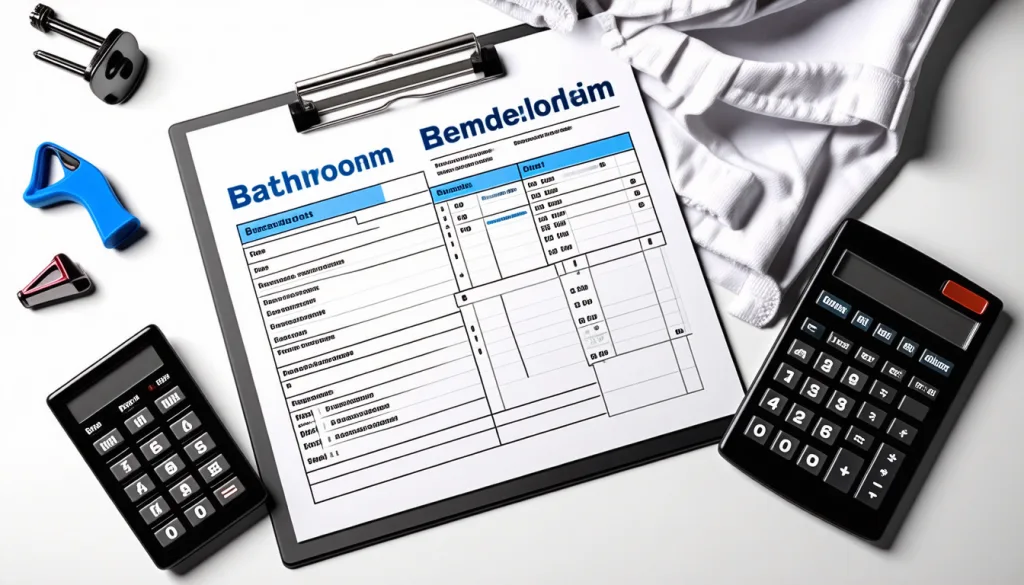Estimating the overall budget for a bathroom remodeling project involves a systematic approach to ensure you can fully capture both expected and unexpected expenses. This budgeting process starts with developing a clear understanding of the scope of your project. Whether you’re undertaking a modest home improvement or a complete overhaul, the cost will largely depend on various critical factors such as the size of the bathroom, the quality of materials chosen, and the extent of changes involved.
To get a precise estimate, consider the following central elements:
- Scope of Work: Define whether the project includes a simple update of fixtures and paint or a more comprehensive renovation involving structural changes and plumbing rerouting.
- Size of the Bathroom: The larger the space, the higher the cost. A bigger bathroom naturally requires more materials and may involve more complex plumbing work.
- Location: Geographic location can significantly impact your costs, with metropolitan areas generally incurring higher expenses than rural locations.
- Project Complexity: Specialized designs or layouts will demand more expertise and possibly prolong the project’s timeline, thereby adding to the cost.
Creating a detailed cost estimate requires a precise breakdown of each element’s anticipated expense. Here’s a simplified example of how you might structure this within your budget:
| Item | Estimated Cost |
| Demolition and Prep Work | $500 – $2,000 |
| Plumbing and Electrical | $1,000 – $3,000 |
| New Fixtures | $200 – $1,800 per fixture |
| Tiling and Flooring | $800 – $3,000 |
| Cabinetry and Countertops | $800 – $5,000 |
| Painting | $200 – $1,500 |
| Total Estimated Cost | $3,500 – $16,300 |
Understanding these components helps you create a realistic budget aligned with your expectations and financial constraints. It’s recommended to allocate an additional 10-20% of the total budget for unforeseen issues, especially those related to plumbing or hidden water damage. This buffer helps avoid financial surprises mid-project and keeps your home improvement plans on track.
Ultimately, being detail-oriented and methodological in your budgeting process increases the likelihood of a successful remodeling outcome that meets both your aesthetic desires and functional needs, while wisely managing expenditures.
estimating the overall budget
After you have a rough estimate of the overall budget, it’s crucial to consider the various essential factors that can significantly affect the final costs of your bathroom remodeling project. Addressing these elements upfront ensures a comprehensive understanding of where your money will be used and helps you make informed decisions throughout the planning and execution phases.
1. Plumbing and Electrical Layout:
– Analyze the existing plumbing and electrical systems to determine if they require updates or relocation. Reconfiguring these systems can be one of the more expensive aspects of home improvement, often demanding specialized skills and permits.
– Decide if you want to keep the current layout or explore more efficient or modern configurations that suit your lifestyle needs.
2. Fixtures and Appliances:
– Consider the current state of your fixtures and appliances. Decide whether they need replacement or if they can be refurbished or reused to cut costs.
– When selecting new fixtures, balance aesthetics with practicality, and compare different models for price, warranty, and energy efficiency features.
3. Space Utilization:
– Evaluate how you use your bathroom space. Could improved storage solutions or layout changes optimize functionality? Potential structural changes, such as moving walls or doors, must be factored into the cost.
– Think about long-term value and convenience, ensuring that any structural changes enhance your daily use and future resale value.
4. Material Selection:
– Materials play a crucial role in both cost and design. From tiles to countertops, the choice can vary significantly in pricing based on quality, durability, and brand.
– Decide on materials that align with your style while also resisting humidity and wear over time. It’s wise to check for sales or bulk discounts.
5. Design Aesthetic:
– Align your bathroom design with the overall home aesthetic to maintain consistency, which can positively impact your home’s market value.
– Hiring a designer might add to upfront costs but could save money in the long term by avoiding costly design mistakes.
By meticulously considering these essential cost factors, you’ll develop a realistic financial plan for your bathroom remodeling project. This strategic mindset not only helps in managing expenditures but also ensures that all critical aspects of the renovation align with your vision and enhance your home’s value and functionality.
essential cost factors
Navigating the diverse elements of a bathroom remodeling project requires an understanding of the essential cost factors that impact your budget significantly. Each component of the remodel comes with its own set of considerations, influencing not only the current expenditures but also the long-term value and functionality of your home improvement.
One of the primary factors involves plumbing and electrical layout changes. Given the complexity and necessity for expertise, any deviation from existing setups can lead to increased costs, as specialized skills and permits are often required. Before deciding to relocate plumbing fixtures or electrical outlets, evaluate whether the changes will genuinely enhance the space’s utility and your daily routines. Retaining the present configuration can minimize expenses and simplify the process significantly.
When it comes to fixtures and appliances, conscious selection is crucial. Knowing the state of your existing fixtures can guide you in deciding whether they warrant replacement or a simple update. Investing in water-efficient and energy-saving models may seem costly upfront but can lead to savings on utility bills over time. Also, explore eco-friendly appliances that offer durability while aligning with green home improvement goals.
Space utilization within your bathroom plays a pivotal role in remodel effectiveness. Examine how your bathroom currently functions and identify areas for improvement without drastic structural changes. Innovative storage solutions can maximize space usage, and minor adjustments like changing door placement or expanding storage can often suffice. If considering significant layout changes, weigh the cost versus the benefits it brings to both daily life and future resale appeal.
Material selection is a significant contributor to the remodeling budget. Consider materials not just for aesthetics but for their resilience in a humid environment like a bathroom. Opting for high-quality materials might stretch the budget initially but ensures long-lasting satisfaction and value. Explore options that blend style with functionality, keeping an eye out for sales or wholesale offers that can reduce expenses without compromising quality.
Lastly, the overall design aesthetic should complement the existing home decor. A consistent style enhances not just personal enjoyment but the perceived value during resale. Engaging a professional designer may involve additional costs, but their expertise could help streamline design decisions and prevent costly mistakes, ensuring that the final outcome aligns perfectly with your vision.
In conclusion, focusing on these critical cost factors ensures you’re strategically directing your resources within the remodeling project. By considering aspects like plumbing infrastructure, effective space use, and thoughtful material choices, you not only control costs but also enhance the functionality and appeal of your home improvement project.
choosing materials wisely
When undertaking a bathroom remodeling project, thoughtfully selecting materials is crucial for balancing aesthetics, durability, and cost. Your choice of materials will significantly affect not only the immediate expenses but also the longevity and maintenance costs of your home improvement endeavor.
Begin by assessing the overall style and functionality you want to achieve. Are you aiming for a modern, minimalist look, or do you prefer a classic, traditional aesthetic? Once you’ve pinpointed your design goals, you can start exploring the vast range of materials available for various components like countertops, flooring, and wall tiles. Each of these elements presents an opportunity to infuse style and personality into the space while making practical decisions about their long-term performance.
For countertops, options range from affordable laminates to high-end materials like quartz and natural stone. Laminate is an economical choice and comes in a plethora of styles and colors. However, if you desire a more luxurious feel, investing in quartz can provide enduring beauty and excellent durability against daily wear and tear. Natural stones like marble and granite offer unparalleled elegance but require sealing and regular maintenance to prevent staining and damage from moisture.
When selecting flooring, consider the unique environmental challenges that a bathroom presents. Moisture resistance should be a top priority. Porcelain and ceramic tiles are excellent choices due to their water resistance and versatility in design. Vinyl flooring, especially the luxury plank variety, mimics the look of hardwood while being water-resistant and budget-friendly. Both options offer durability and ease of cleaning, making them practical for high-traffic areas.
Wall materials can transform the bathroom into a serene retreat. Popular choices include ceramic and glass tiles, which can add texture and color without compromising on maintenance. A timeless subway tile pattern might suit those seeking a minimalist or vintage charm, while mosaic designs can provide eye-catching splashes of interest. Additionally, waterproof wall panels like acrylic or fiberglass offer cost-effective solutions with straightforward installation.
Cabinetry and storage present another opportunity to choose materials that enhance both the form and function of your bathroom. Solid wood offers classical beauty and strength but can be expensive. Plywood or medium-density fiberboard (MDF) can be cost-effective alternatives, particularly if they’re protected by a high-quality laminate or veneer that defends against humidity-induced warping.
Finally, assess the finishes for fixtures, such as faucets and showerheads. Chrome, brushed nickel, and oil-rubbed bronze are durable and visually appealing, each offering varying levels of maintenance requirements and cost. Ensure that your selections coordinate with the overall design theme to create a unified look.
In making these selections, it’s important to strike a balance between price and quality. Consider the longevity of the materials against their initial cost to ensure that your investment results in a bathroom that not only meets your immediate design desires but also withstands the test of time. Opting for high-quality materials where it matters can save you from future repairs and replacements, contributing to a successful and enduring home improvement project. Keep in mind that the choices you make today will impact not only the current look and feel of your bathroom but also its market value for years to come.
labor costs and considerations
When planning for the labor component in your bathroom remodeling project, understanding the associated costs and considerations is vital to keep your budget in check while ensuring quality results. Labor costs often constitute a significant portion of your overall remodeling expenses, so it’s crucial to approach this aspect with careful planning and diligence.
The cost of labor can vary broadly based on several factors, starting with the complexity and scope of the project. Basic updates, such as replacing fixtures or repainting, might require fewer skilled professionals and can be done at a lower cost. On the other hand, more intricate projects, such as reconfiguring plumbing systems or adding new electrical outlets, necessitate experienced tradespeople like electricians, plumbers, and tile setters. These professionals typically charge higher rates due to their specialized skills and the need for precision in their work.
Another consideration is the geographical location of your home, as labor costs can be significantly higher in urban and metropolitan areas compared to rural settings. It’s beneficial to obtain multiple quotes from contractors, assess their previous work, and review customer testimonials to ensure that you’re hiring reputable professionals. While it’s essential to negotiate prices, prioritize quality and reliability over cost alone to avoid corners being cut, which might lead to issues down the line.
Before hiring contractors, it’s also important to clarify what services are included in their quotes. Clarify if their fees cover demolition, waste removal, cleanup, and any permits required by local regulations. Understanding these details beforehand prevents unexpected surprises and allows you to allocate your resources better.
Moreover, consider the timing of your project. Busy seasons can drive up costs as contractors have more work and may charge premium rates. Planning your remodel during a less busy period can not only save you money but might also mean faster project completion.
Finally, communication is key to successful project completion. Ensure you regularly communicate with your contractors to stay in the loop about progress and address any potential issues as they arise. Keeping open lines of communication helps to minimize misunderstandings and ensures that the project adheres to your envisioned timeline and budget.
In conclusion, bathroom remodeling can seem daunting with its complex blend of budgeting, design choices, and technical requirements. By allocating enough time to plan, prioritize spending on essential areas, and employing skilled professionals, you ensure a smoother remodeling experience. Respect your budget without compromising quality, and remember that each choice contributes to creating a functional, attractive space that enhances your home both in comfort and value.
money-saving tips
Embarking on a bathroom remodeling journey can be as financially taxing as it is exciting, but employing strategic money-saving tips can help you achieve your dream space without breaking the bank. Leveraging creativity and resourcefulness plays a significant role in maximizing value without sacrificing quality or functionality.
To begin with, consider retaining the existing plumbing layout. Moving sinks, toilets, or bathtubs increases costs due to extensive plumbing work and permits. If your current layout is functional, opting to refresh the fixtures instead can achieve a transformative effect at a fraction of the cost.
Another savvy approach is to explore refinishing over replacing. Instead of purchasing a new bathtub or shower, consider reglazing or refinishing them. This method revitalizes the current fixtures, extending their life and significantly reducing expenditure. Similarly, refinishing or repainting cabinets can restore their appearance and provide a fresh look without the expense of new installations.
For those seeking new materials, shopping for sales or remnants can lead to substantial savings. Countertop fabricators often sell remnants of high-quality materials at reduced prices, which could be perfect for smaller spaces like bathroom vanities. Periodically checking local hardware stores for sales on items like tiles, fixtures, and accessories allows you to procure coveted styles without overspending.
- Alternative Materials: Consider using cost-effective alternatives that emulate the look of high-end products. For example, luxury vinyl tiles can mimic the appearance of natural stone or wood without straining the budget, offering durability and elegance.
- DIY Enthusiasm: Take on parts of the project yourself where possible. Painting, installing simple fixtures, or assembling cabinets can cut down on labor expenses. However, ensure tasks like electrical and plumbing work are left to certified professionals to avoid costly errors.
- Smart Fixture Choices: Invest in fixtures that offer efficiency and sustainability, such as water-saving toilets or low-flow showerheads. Initially, they may be more expensive, but they lead to savings on utility bills in the long term, enhancing both the project’s return on investment and your home improvement satisfaction.
Additionally, staggered purchasing or completing the remodel in stages can further assist with cash flow management. Addressing the bathroom remodel in phases allows you to manage costs effectively and avoid stretching finances too thin too quickly.
Lastly, don’t overlook the power of negotiation. When hiring contractors, negotiate not just prices but the scope of work to ensure you’re getting the best possible agreement. Gathering multiple quotes and comparing them helps identify reputable contractors who fit both your budget and quality standards.
By combining these money-saving strategies, you can achieve a beautiful, functional bathroom remodel. These tips not only help in managing immediate costs but also contribute to enhanced home improvement satisfaction, ensuring you create a space that uplifts everyday experiences while respecting your financial realities.






